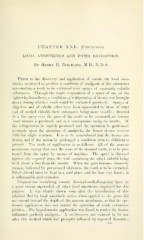Page 641 - My FlipBook
P. 641
;
CHAPTER XXI. (Concluded).
LOCAL ANESTHETICS AND TOOTH EXTRACTION.
By Henry H. Burchard, M. D., D. D. S.
Prior to the discovery and application of cocain, the local anes-
thetics employed to produce a condition of analgesia of the structures
surrounding a tooth to be extracted were sprays of extremely volatile
substances. Through the rapid evaporation of a spray of one of the
lighter hydrocarbons, a condition of refrigeration of tissues was brought
al)out during which a tooth could be extracted painlessly. Sprays of
rhigolene and of ethylic ether have been superseded by those of ethyl
and of methyl chlorid, these substances being more volatile ; directed
in a tine spray over the gum of the tooth to be extracted, an intense
local anemia is produced, and as a consequence analgesia results. If
the refrigeration be rapidly produced and the operation be performed
promptly upon the attaining of analgesia, the frozen tissues recover
with but slight reaction. It is to be remembered that the tissues are
frozen, and if the action be prolonged a condition akin to chilblain is
present. The mode of application is as follows: All of the mucous
membrane, except that over the roots of the doomed tooth, is to be pro-
tected from the spray by means of napkins. The spray is directed
against the exposed gum, the vial containing the ethyl chlorid being
held about a foot from the mouth. When the gum becomes intensely
anemic, indicated by pronounced whiteness, the tooth is to be extracted.
Ethyl chlorid must be kept in a cool place, and far from any flame it
;
is inflammable and explosive.
Preparations containing cocain (benzoyl-methyl-ecgonin) have to
a great extent superseded all other local anesthetics employed for this
purpose. It was clearly shown soon after the introduction of this
alkaloid that its local anesthetic action when apjilied to the gums did
not extend beyond the depth of the mucous membrane, so that its epi-
dermic application does not render the operation of tooth extraction
painless. The hypodermatic application was found to render the tissues
infiltrated perfectly analgesic. A recklessness was evinced in its use
after this method which was promptly followed by repeated disasters
639
CHAPTER XXI. (Concluded).
LOCAL ANESTHETICS AND TOOTH EXTRACTION.
By Henry H. Burchard, M. D., D. D. S.
Prior to the discovery and application of cocain, the local anes-
thetics employed to produce a condition of analgesia of the structures
surrounding a tooth to be extracted were sprays of extremely volatile
substances. Through the rapid evaporation of a spray of one of the
lighter hydrocarbons, a condition of refrigeration of tissues was brought
al)out during which a tooth could be extracted painlessly. Sprays of
rhigolene and of ethylic ether have been superseded by those of ethyl
and of methyl chlorid, these substances being more volatile ; directed
in a tine spray over the gum of the tooth to be extracted, an intense
local anemia is produced, and as a consequence analgesia results. If
the refrigeration be rapidly produced and the operation be performed
promptly upon the attaining of analgesia, the frozen tissues recover
with but slight reaction. It is to be remembered that the tissues are
frozen, and if the action be prolonged a condition akin to chilblain is
present. The mode of application is as follows: All of the mucous
membrane, except that over the roots of the doomed tooth, is to be pro-
tected from the spray by means of napkins. The spray is directed
against the exposed gum, the vial containing the ethyl chlorid being
held about a foot from the mouth. When the gum becomes intensely
anemic, indicated by pronounced whiteness, the tooth is to be extracted.
Ethyl chlorid must be kept in a cool place, and far from any flame it
;
is inflammable and explosive.
Preparations containing cocain (benzoyl-methyl-ecgonin) have to
a great extent superseded all other local anesthetics employed for this
purpose. It was clearly shown soon after the introduction of this
alkaloid that its local anesthetic action when apjilied to the gums did
not extend beyond the depth of the mucous membrane, so that its epi-
dermic application does not render the operation of tooth extraction
painless. The hypodermatic application was found to render the tissues
infiltrated perfectly analgesic. A recklessness was evinced in its use
after this method which was promptly followed by repeated disasters
639


